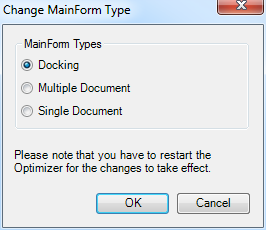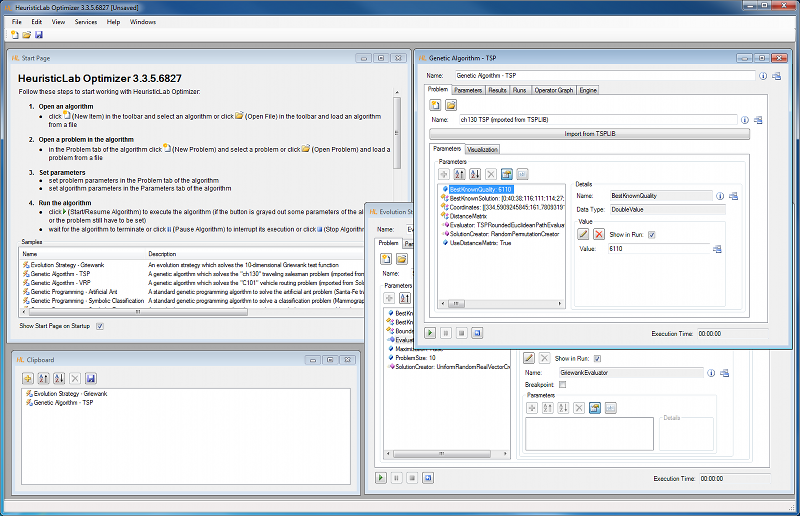Update on User Interface resizing problem in HeuristicLab
As mentioned in a previous Blog post there are some users who are experiencing problems with the user interface not resizing correctly. With HeuristicLab 3.3.6 there will be an option to switch to other document window styles where this problem doesn't occur. In 3.3.6 you will find an entry "View -> Change MainForm Type" in the menubar. This opens a dialog where you can choose between different MainForm types:
There are 3 types of MainForms which can be used. The Docking MainForm is the standard HeuristicLab user interface where documents are displayed as tab pages:
Additionally there is a Multiple and a Single Document option. The Multiple Document MainForm displays documents as windows within the HeuristicLab main window:
The Single Document MainForm creates for each document an own window which is also shown in the Windows taskbar:
The resizing issue doesn't occur with the Single and Multiple Document styles. This means you can use these different document window styles and don't have to switch to another language or DPI size (see UsersFAQ?).
These changes are already in trunk and you can try them out if you are affected by this problem.
User Interface resizing problem in HeuristicLab
On some machines it might happen that controls are not correctly resized and the HeuristicLab GUI looks like this:
This behavior results from a bug in the GUI frameworks (either Windows Forms or the Dock Panel Suite). There are two known causes for this problem. The first one is that the Windows text size is set to a value larger than 100%. To avoid this bug, the Windows text size in the Windows display settings has to be set to 100%. This can be done in the dialog shown below which can be opened from the Windows Control Panel (Control Panel -> Appearance and Personalization -> Display).
The other possible cause for this problem is the "Language for non-Unicode programs" setting of your Windows operating system. There are some languages which we know cause a resizing problem in HeuristicLab, e.g. Latvia. German or English on the other hand work fine. A possible workaround at the moment would be that you switch this setting to German or English. The downside of this is however that applications which don't support Unicode might not display text correctly anymore. The following screen shot shows how you can change the setting:
We are at the moment further investigating the problem and hope to come up with a fix for this bug soon.
Financial Analysis with HeuristicLab
One application that I've been interested in lately is financial analysis.
Recently I've looked at interest rate swaps in more detail. Interest rate swaps are an important financial instrument for controlling risk, but are also used for speculative purposes. Using the genetic programming capabilities of HeuristicLab it is relatively easy to generate a regression model to estimate the interest rate swap yield. The result for the European 10-year interest rate swap (monthly data) in the time span from April 1991 until August 2011 can be seen in the next figure.
In the last section from index 582 onwards (July 2007 - August 2011) the output of the model (red line) deviates very strongly from the actually observed values.
To get a better idea of the underlying relations found by GP it is interesting to study variable impacts. The most important variables for the 10-year European interest rate swap yield found through the genetic programming runs are:
| Most relevant variables | Hold out set |
|---|---|
| US M1, US Mortgage Market Index | March 1991 - April 1995 |
| Eurozone Employment qq, US M1, US Corporate Profits | April 1995 - May 1999 |
| US Corporate Profits, Eurozone Employment qq, US U Michigan Expectations Prelim. | May 1999 - June 2003 |
| US Corporate Profits, Eurozone Employment qq | June 2003 - July 2007 |
| US Existing Home Sales | July 2007 - August 2008 |
Interestingly the most important variables differ for different time spans. Only the corporate profits and the number of employed persons in the Euro zone are detected as relevant over a larger time span.
The following table shows the variable impact calculation results for the first fold in greater detail. It can be clearly seen that money supply M1 in the US and the US mortgage market index are used repeatedly in all models. This is a strong indicator that there is a strong correlation of these variables and the interest rate swap yield for the time span from April 1995 until August 2011 which was used as training set for these models. As can be seen in the previous chart the output on the hold out set (March 1991 - April 1995) is relatively accurate.

HeuristicLab Blog
Keep up with HeuristicLab development! Our developers post about new, exciting features they are working on, provide links to tutorials, teaching materials and additional goodies in the Blog.

 rss
rss






